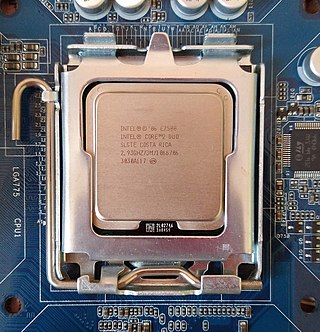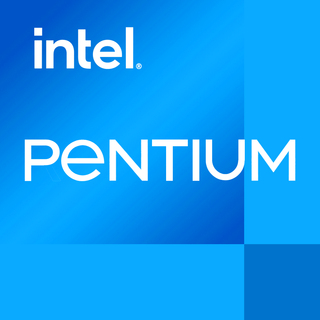
The Intel 80186, also known as the iAPX 186, or just 186, is a microprocessor and microcontroller introduced in 1982. It was based on the Intel 8086 and, like it, had a 16-bit external data bus multiplexed with a 20-bit address bus. The 80188 variant, with an 8-bit external data bus was also available.

A workstation is a special computer designed for technical or scientific applications. Intended primarily to be used by a single user, they are commonly connected to a local area network and run multi-user operating systems. The term workstation has been used loosely to refer to everything from a mainframe computer terminal to a PC connected to a network, but the most common form refers to the class of hardware offered by several current and defunct companies such as Sun Microsystems, Silicon Graphics, Apollo Computer, DEC, HP, NeXT, and IBM which powered the 3D computer graphics revolution of the late 1990s.

Fujitsu Siemens Computers GmbH was a Japanese and German vendor of information technology. The company was founded in 1999 as a 50/50 joint venture between Fujitsu Limited of Japan and Siemens of Germany. On April 1, 2009, the company became Fujitsu Technology Solutions as a result of Fujitsu buying out Siemens' share of the company.

Intel Core 2 is the processor family encompassing a range of Intel's consumer 64-bit x86-64 single-, dual-, and quad-core microprocessors based on the Core microarchitecture. The single- and dual-core models are single-die, whereas the quad-core models comprise two dies, each containing two cores, packaged in a multi-chip module. The Core 2 range was the last flagship range of Intel desktop processors to use a front-side bus.

Pentium was a series of x86 architecture-compatible microprocessors produced by Intel. The original Pentium was first released on March 22, 1993.

Intel Active Management Technology (AMT) is hardware and firmware for remote out-of-band management of select business computers, running on the Intel Management Engine, a microprocessor subsystem not exposed to the user, intended for monitoring, maintenance, updating, and repairing systems. Out-of-band (OOB) or hardware-based management is different from software-based management and software management agents.

Dell Precision is a series of computer workstations for CAD/architecture/CG professionals, or as small-scale business servers. They are available in both desktop (tower) and mobile (laptop) form. Dell touts their Precision Mobile Workstations are "optimized for performance, reliability and user experience."

The Platform Controller Hub (PCH) is a family of Intel's single-chip chipsets, first introduced in 2009. It is the successor to the Intel Hub Architecture, which used two chips–a northbridge and southbridge, and first appeared in the Intel 5 Series.

Haswell is the codename for a processor microarchitecture developed by Intel as the "fourth-generation core" successor to the Ivy Bridge. Intel officially announced CPUs based on this microarchitecture on June 4, 2013, at Computex Taipei 2013, while a working Haswell chip was demonstrated at the 2011 Intel Developer Forum. With Haswell, which uses a 22 nm process, Intel also introduced low-power processors designed for convertible or "hybrid" ultrabooks, designated by the "U" suffix.
The Opal Storage Specification is a set of specifications for features of data storage devices that enhance their security. For example, it defines a way of encrypting the stored data so that an unauthorized person who gains possession of the device cannot see the data. That is, it is a specification for self-encrypting drives (SED).
PRIMERGY is Fujitsu's brand name for x86-architecture designed servers. The brand name PRIMERGY represents a range of servers from single-socket over dual-socket to quad-socket systems. Eight socket systems are branded differently with "PRIMEQUEST," whereas Fujitsu servers in the UNIX/Mainframe world, also known as SPARC systems, are named "Fujitsu M10" and mainframes "BS2000."

Skylake is the codename used by Intel for a processor microarchitecture that was launched in August 2015 succeeding the Broadwell microarchitecture. Skylake is a microarchitecture redesign using the same 14 nm manufacturing process technology as its predecessor, serving as a tock in Intel's tick–tock manufacturing and design model. According to Intel, the redesign brings greater CPU and GPU performance and reduced power consumption. Skylake CPUs share their microarchitecture with Kaby Lake, Coffee Lake, Cannon Lake, Whiskey Lake, and Comet Lake CPUs.

The ThinkStation is a line of professional workstations from Lenovo. They are designed to be used for high-end computing and CAD tasks and primarily compete with other enterprise workstation lines, such as Dell's Precision, HP's Z line, and Apple's Mac Pro line.

Lenovo Yoga is a line of consumer-oriented laptop computers and tablets designed, developed and marketed by Lenovo, named for their ability to assume multiple form factors due to a hinged screen.
Intel Ivy Bridge–based Xeon microprocessors is the follow-up to Sandy Bridge-E, using the same CPU core as the Ivy Bridge processor, but in LGA 2011, LGA 1356 and LGA 2011-1 packages for workstations and servers.

The Intel Management Engine (ME), also known as the Intel Manageability Engine, is an autonomous subsystem that has been incorporated in virtually all of Intel's processor chipsets since 2008. It is located in the Platform Controller Hub of modern Intel motherboards.
Sapphire Rapids is a codename for Intel's server and workstation processors based on Intel 7.
Cascade Lake is an Intel codename for a 14 nm server, workstation and enthusiast processor microarchitecture, launched in April 2019. In Intel's Process-Architecture-Optimization model, Cascade Lake is an optimization of Skylake. Intel states that this will be their first microarchitecture to support 3D XPoint-based memory modules. It also features Deep Learning Boost instructions and mitigations for Meltdown and Spectre. Intel officially launched new Xeon Scalable SKUs on February 24, 2020.

The ThinkPad P series line of laptops is produced by Lenovo and was introduced by the company as a successor to the previous ThinkPad W series. With 15.6" and 17.3" screens, the ThinkPad P series saw the reintroduction of physically large laptops into the ThinkPad line. Marketed largely as portable workstations, many P series laptops can be configured with high-end quad-core, hexa-core or octo-core Intel processors as well as ECC memory and a discrete Nvidia Quadro GPU. The P series offers ISV certifications from software vendors such as Adobe and Autodesk for various CAD software. The P52 and P72 models are the last current Lenovo laptops with a dedicated magnesium structural frame.














